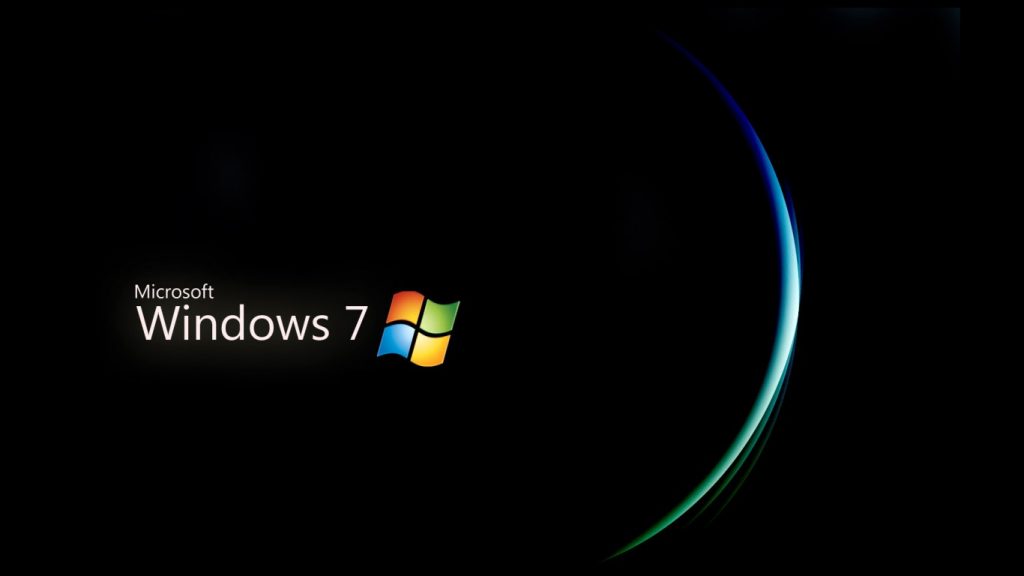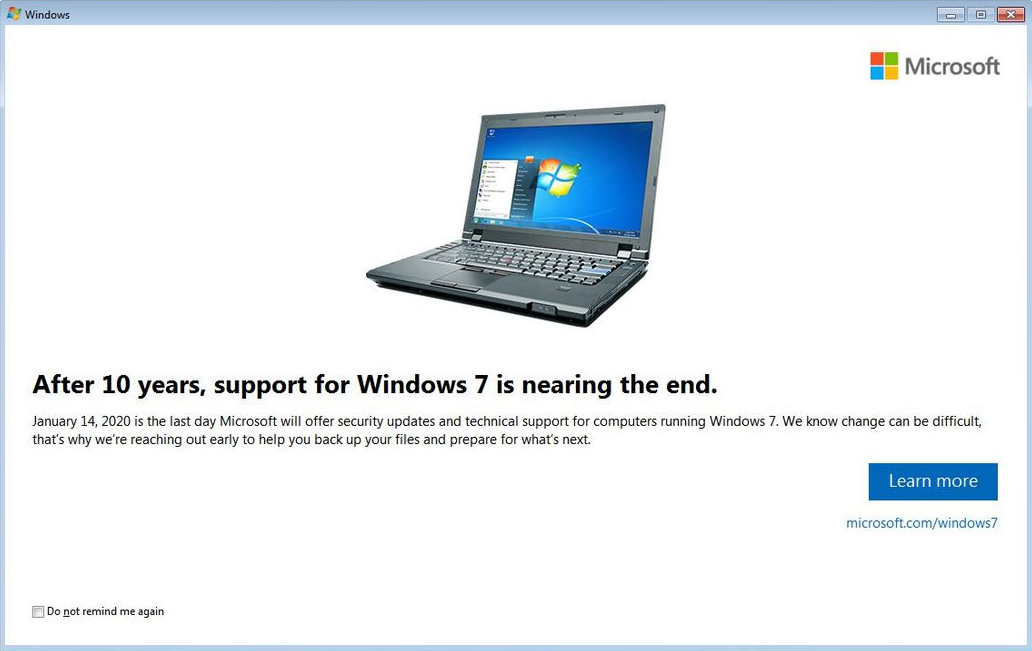Windows 7 is “no longer supported.” Should you upgrade? Should you buy new?

(Scroll to the end for our local Windows 10 upgrade offer.)
Windows 7 support ends January 14, 2020, and Microsoft is letting everyone know, and lots of people think their computers will magically catch on fire and never work again in 2020. (Okay, I’m kidding about the fire part.)

If you’re reading this, you probably want to know what this means and what you’re supposed to do about it. Fear not, dear reader, because Tritech Computer Solutions is here to help. Here’s the biggest thing to remember about Windows 7 support ending:
Windows 7 will not stop working without “support.”
As long as you can keep it working, your Windows 7 computer will continue to work as it currently does, even without receiving support from Microsoft. The question that often isn’t asked is: “what does ‘support’ mean?” In short, it means that Microsoft provides updates to the operating system that improve security and sometimes fix bugs and add small features. Let’s talk about what you get from Microsoft’s “Windows 7 support.”
What Windows 7 “support” really means
The biggest benefit of “support” (which really just means “updates”) is receiving security updates. Without receiving security updates, any future security issues found in Windows 7 will not be fixed, but that’s not necessarily as serious as it sounds. Many of the security issues plugged by security updates tend to be minor or difficult to exploit in the first place. There are rare occasions that a major security hole in Windows is found, and even if there’s a major security hole, someone has to try to exploit it before it can impact you. Now, obviously, it’s not the best plan to assume that it will never happen to you, but the likelihood of being hit through one of these unplugged security holes is not very high. Microsoft has also been known to release “out-of-band” updates for unsupported systems if a security flaw is so big that it can cause a widespread infection, so “no support” isn’t even necessarily 100% truthful if the problem is big enough.
One of my own machines is a Windows 7 computer used primarily for media production software. I do not allow it to update from Microsoft and I don’t update the production software either. It has no issues and continues to run its original Windows 7 installation to this day without incident. I have manually installed a very small number of updates for high-profile security concerns and bug fixes, but that’s only about 20 out of the thousands of updates for Windows 7 over the years. The machine will continue to run Windows 7 until I have to upgrade it for some reason. I don’t see any benefits from Microsoft’s “support” because I don’t generally use it online in the first place and I’m very careful about what I run on it.
What “no support” means beyond just the updates
This is where it gets a little more ugly. When a Windows version is no longer supported, it doesn’t get updates from Microsoft anymore. No big deal if you understand the risks, right? Well…there’s a broader (and more troublesome) problem with Windows 7 support ending, and it can be seen through the progress beyond Windows XP’s end-of-life.
Anyone who was running Windows XP in 2014 got an end-of-life notice message from Microsoft that year, and nothing happened immediately. The problem is that the software environment surrounding Windows XP started to dry up. Microsoft’s own software development platforms slowly stopped supporting building software for Windows XP, meaning that using the latest development tools would slowly force software developers to drop XP whether they wanted to or not. Mozilla Firefox was the last modern web browser to drop support for Windows XP, so no one with Windows XP today can run a modern browser. Hardware manufacturers stopped providing drivers and software for Windows XP, meaning that if you replaced your aging printer with a brand new one, you might find out when you get it home that it wouldn’t install on Windows XP at all. If you ran Adobe Photoshop and you paid for the latest Photoshop version, you’d find out that the new version simply wouldn’t install on XP.
With no new software supporting the system and some software (particularly web browsers) requiring fairly regular updates to continue working properly in an environment full of other up-to-date computers and contemporary web and encryption standards, Windows XP’s usefulness became prohibitively limited as the years passed beyond the 2014 EOL announcement. If you’re running XP on something today, it’s probably a secondary computer, and you probably have it because you want to run outdated software such as old video games or the code that powers a $100,000 metal processing machine in your machine shop. It still works perfectly fine, sure, but the software/hardware world it lives within is frozen in a past era. The browser support is a particularly serious problem, and the original Internet Explorer 6 that shipped with Windows XP can’t even access most secure websites on today’s internet due to an encryption weakness scare several years back that prompted most websites to change their weaker encryption methods to much stronger ones that weren’t even available in the days of IE6.
The same will happen to Windows 7 and to holdouts who don’t upgrade to Windows 10: in the beginning, nothing will change, but eventually it’ll be a challenge (or even impossible) to check your web mail or get a replacement printer or upgrade a piece of software.
Should I buy a new computer instead of upgrading?
This depends heavily on the computer. In general, very old or slow computers should be replaced, but most $400+ computers made since 2010 are great upgrade candidates. Let’s talk about this in two parts: what you can definitely shoot down and what might be a viable upgrade candidate. If you need to see your computer’s model number, processor, RAM, and other information, run the System Information tool by holding the Windows key and hitting R (Win+R), then typing “msinfo32” and hitting enter.
Don’t bother considering an upgrade for…
- Anything that has a Windows XP or Vista sticker on it is not a good candidate for a Windows 10 upgrade.
- The same goes for older netbooks with Windows 7 Starter Edition stickers on the bottom–such as the Acer Aspire One series–which perform extremely poorly under Windows 10.
- If your computer has an older Intel Celeron processor (such as the Intel Celeron 530, N2805, or 900) or one of the AMD C-series, E-series, or V-series processors (such as the AMD C-50, E-350, or V140), you should definitely ditch it and buy something newer. Even though many computers from the Windows 7 era with weak CPUs can have a CPU upgrade installed, the labor is too expensive to justify the cost, and laptop processor upgrade compatibility can be a bit dicey as it varies from model to model.
- Computers with power or battery issues. Though it may be fixable by a computer shop, a computer with a Windows 7 sticker that has power problems may have failing power regulation circuitry, and once that fails completely, your upgrade effort was wasted.
- Any major hardware repair waiting to be done (that’s not hard drive replacement) is likely to make a new computer a better choice. Examples include a cracked screen, hinge damage, or “blown” capacitors on the motherboard.
- Computers that run special proprietary software such as a machine control computer; the software may not work at all on Windows 10 and you may lose use of the software (and, by extension, any equipment that the software operates) entirely.
Definitely consider an upgrade for…
- Anything that came with Windows 8 or Windows 8.1 when it was new.
- Any computer that has been upgraded to a solid-state drive (SSD) instead of a traditional rotating hard drive.
- Any Windows 7 computer that has an Intel Core i3 second-generation (ending in 2xxx) or higher (or AMD FX-series or higher) processor.
Advice for those looking to upgrade
- Back up your data before you do anything, and take that backup to a friend’s Windows 10 computer to make sure your backup actually works.
- No, really, BACK UP YOUR DATA BEFORE YOU DO ANYTHING. You can’t replace your data and it may get destroyed during the upgrade.
- If you save your login passwords in your browser or mail client, you should make sure you know your passwords. They won’t carry over. Some browsers (such as Mozilla Firefox) have an area where you can see your saved website/login/password combinations.
- If you won’t be upgrading your hard drive, check your current hard drive’s S.M.A.R.T. status with CrystalDiskInfo to make sure you don’t have an avoidable hardware failure looming.
- If your computer has a normal hard drive, this is the absolute best time to upgrade to a solid-state drive (SSD) and doing so is very highly recommended. A $500 computer from 2010 with a 240GB SSD upgrade and Windows 10 will feel SO much faster than a brand new $500 computer that comes with a 1TB hard drive. SSDs are the single best upgrade you can buy.
- If your computer has less than 4GB of RAM, it is a very good idea to go ahead and upgrade the RAM to 4GB or more. RAM upgrades are fairly cheap, 4GB is possible with almost every computer that isn’t on the “do not upgrade if” list above, and you can see potential benefits up to about 8GB of RAM.
- Don’t bother upgrading RAM past 8GB unless you’ll be running very heavy professional applications that require it (such as Adobe Premiere Pro). It’s a waste of money.
- It’s often more convenient to upgrade the RAM and hard drive at the same time, especially if you’re paying a computer repair shop to do it for you, so do all of these upgrades at once.
- Don’t do an in-place upgrade install of Windows 10; for some reason, upgrade installs tend to fail far more often than “clean” Windows 10 installs, so we recommend avoiding the upgrade route. Instead, do a clean install of Windows 10 from scratch. Download the Windows 10 Media Creation Tool to make a bootable Windows 10 installation USB flash drive or DVD. If a repair shop is doing the work, ask them to do a clean install rather than an upgrade install. Make sure you have installation discs and keys for all of your software handy!
Advice for the brave souls who stick with Windows 7
- Force Windows updates to run now, and keep checking for updates weekly until the end of support hits. You may as well get all of the updates you can ASAP.
- Check your hard drive’s S.M.A.R.T. status with CrystalDiskInfo to make sure you don’t have an avoidable hardware failure looming.
- Don’t assume you won’t need to move to Windows 10 in the future. At some point, you’ll be forced to do so because of circumstances out of your control. Make sure you have your installation media and product keys for all of your software. Make sure you know all of your passwords for your online accounts.
- If you don’t have any sort of data backup, you need to set one up. Windows 7’s “Backup and Restore” in the Control Panel works wonderfully, and its backups are accessible in Windows 10. External hard drives are fairly cheap nowadays, and if your old machine suddenly fails, you won’t lose all of those important family photos and documents. Alternatively, you may want to use Dropbox, OneDrive, Box, or a similar cloud storage provider. You can back up your bookmarks/favorites using the Sync feature of Mozilla Firefox or Google Chrome.
- Because you will face higher security risks over time, you need to plan accordingly. In particular, having a data backup is crucial, because if you get hit with some sort of CryptoLocker-style malware that holds your data for ransom, you need that backup to get it back without paying hundreds of dollars and potentially committing a federal felony by violating United States sanctions.
- Make sure that you have the appropriate Windows 7 installation media and license information handy so you can reinstall Windows 7 if something goes wrong. As the years go by, getting your hands on installation media will become more and more difficult.
- The installation media advice also goes for program installers! The entire Windows Live suite was discontinued by Microsoft and made unavailable several years back, and Google took down Picasa around the same time, yet they are both still popular programs today. It is difficult to find legitimate installers for these programs today.
- Save up to buy a new computer in the future. Seriously, you can’t hold out forever, so be prepared to shell out some money on a new machine at some point.
I’m in central North Carolina and I need a reputable computer shop!
Email us at Tritech Computer Solutions: tritech@nctritech.com – or call us at (919) 200-6003. We’ll be happy to help you with your Windows 10 upgrade needs.
Our in-shop price for a clean Windows 10 upgrade install is $90 and includes backing up your data, physically replacing your hard drive (if necessary), installing and licensing Windows 10, installing some basic software (Adobe Reader, Mozilla Firefox, etc.), and restoring your backed-up data.
If you have a business with a large number of computers requiring an upgrade, call us to discuss an on-site batch migration session. After-hours sessions are available to minimize disruption. On-site services are billed at an hourly rate plus a trip charge rather than a flat fee.
Asheboro Burlington Chapel Hill computer repair Durham Greensboro NC North Carolina onsite Pittsboro Raleigh Sanford services Siler City update update to Windows 10 upgrade upgrade to Windows 10 Windows 10 windows 7

2 Responses
How do I find out which Windows I have?
The one quick way that works on basically every Windows system in use today is to hold the Windows logo key and hit R, then let go of both and type “msinfo32” in the Run box that appears. The Windows version will be at the very top of the right-hand side.
Alternatively, you can open the Control Panel and open the one called “System.” The Windows edition will be shown at the top. It’s difficult to open the old-style Control Panel if you are using Windows 10, though, so the “msinfo32” option is the only one I can guarantee to be usable everywhere, including on Windows 10.
If your computer was brand new in 2016 or later, you’re basically guaranteed to have Windows 10 already. The Windows version release years (as best as I can remember them) are:
2002 – Windows XP
2006 – Windows Vista
2009 – Windows 7
2012 – Windows 8
2013 – Windows 8.1
2015 – Windows 10